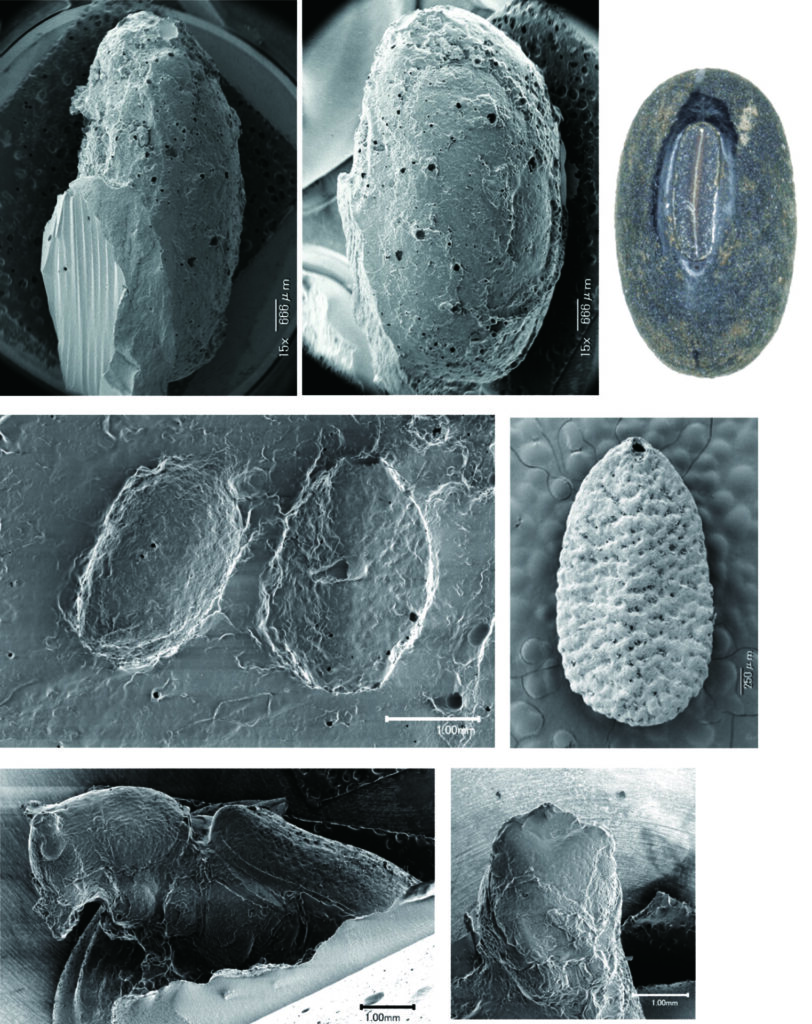Archaeobotany – Impressions of Seeds and Insects found in Pottery Impressions
Earthenware vessels have pits (impressions) on their surfaces and cross-sections, casts of seeds and insects mixed into the clay during pottery making processes. By obtaining negative casts of these impressions with molding silicone rubber, the type of seeds and insects can be identified by observing with a scanning microscope. This method is known as the ‘replica method’.
Analyses of the impressions on pottery unearthed from the Iyai rock shelter site using the ‘replica method’ revealed seven seed impressions on a total of 1743 potsherds dating to the initial Jomon period (an identification rate of 0.4%). These impressions included legume genera such as soybean and subgenus azuki, along with the plasma fruit genus grape. Moreover, three indentations were found on 856 potsherds dating to the first half of the early Jomon period (an identification rate of 0.5%), including one of the Perilla genus (shisho) similar in size to the cultivated plant Egoma and one of Sambucus racemosa subsp. sieboldiana (Japanese red elder) (Sasaki and Yamamoto 2023). Interestingly these plants are all edible, indicating their presence in the vicinity when the pottery was made.
Soybean seed indentations discovered on pottery from the middle part of the initial Jomon period (Chinsenmon type) measured 7.53 mm in residual length, 4.87 mm in width, and 3.52 mm in thickness. These dimensions are larger than the average size of the ancestral wild soybean species, Glycine soja, which is typically around 4 mm long, but were smaller than its maximum length of 10 mm (Nasu 2018). While the exact size of the seedpods in their raw stage remains unknown due to expansion with clay moisture and contraction during pottery firing, this evidence signifies the commencement of legume use at least by the middle phase of the initial Jomon period.
Indentations of Japanese red elder seeds, found on pottery from the first half of the early Jomon period represented not the edible parts of the fruit, but two internal nuclei located in close proximity. It is plausible that the kernel, the residual part after extraction of the fruit juice, was incorporated into the clay for some reason.
Additionally, a pot shard from the end of the early Jomon period displayed an indentation of a beetle, possibly belonging to the weevil family (Mori et al. 2023). Identifying the exact beetle species might enable inferring its habitat, shedding light on the pottery-making environment and the potential for an insect-based diet.
The study of earthenware impressions reveals diverse information, and the ‘replica method’ stands as a valuable tool for examining plant and insect species at archaeological sites, particularly at plateau sites where living plants and insects are usually not preserved. Moreover, pottery dating aids in establishing chronological sequences of plants and insects at this site.
References
Sasaki, Y. and Yamamoto, H. (2023) ‘Analysis of indentations on pottery’, Iyai Iwakage Iseki III [Archaeological Research at the Iyai Rock Shelter Site III], pp.244-249, Kokugakuin University, Faculty of Letters, Department of Archaeology.
Nasu, H. (2018) Domestication of plants during the Jomon period. The Quaternary Research 57: 109–126 (in Japanese with English summary)
Mori, Y. (2023) ‘Analysis of insect indentations on pottery using the ‘replica method”, Iyai Iwakage Iseki III [Archaeological Research at the Iyai Rock Shelter Site III], pp.251-253, Kokugakuin University, Faculty of Letters, Archaeological Research Office.
